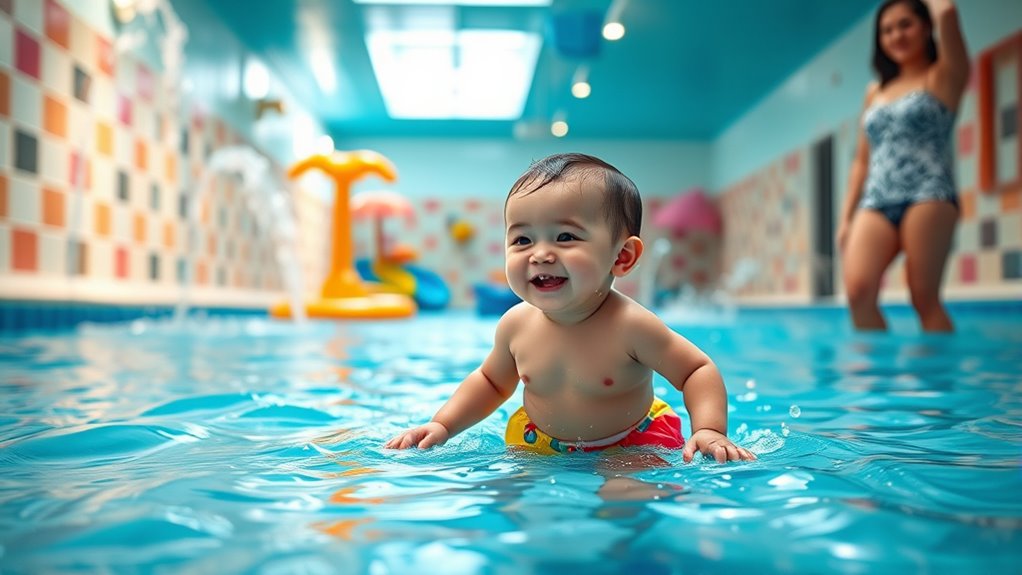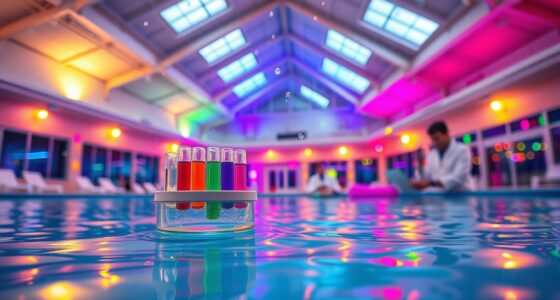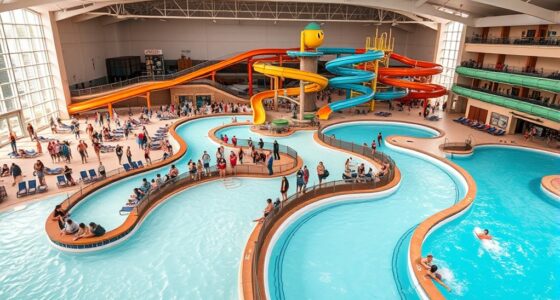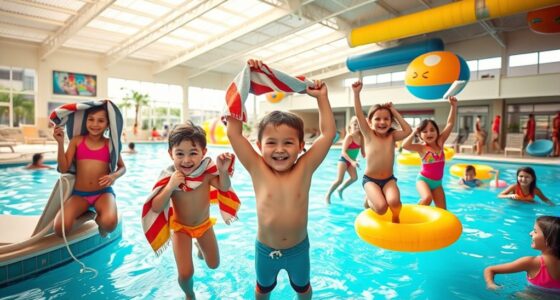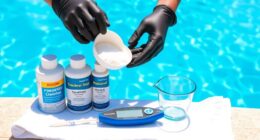Yes, babies can go to indoor water parks if you follow safety guidelines and use swim diapers. Keep a close eye on your child at all times, maintaining close supervision and using life jackets when needed. Make certain the swim diapers fit snugly and are changed frequently to keep the water clean. Be aware of potential hazards like slippery surfaces and strong currents. To learn more about keeping your little one safe and comfortable, keep exploring the tips below.
Key Takeaways
- Babies can visit indoor water parks if they wear proper, snug-fitting swim diapers to prevent leaks and contamination.
- Constant supervision, including an adult-to-child ratio, is essential for babies’ safety in water park environments.
- Use Coast Guard-approved life jackets for added buoyancy and safety for babies in deeper or open water areas.
- Ensure water quality is maintained with proper chemical levels and hygiene practices to protect babies’ skin and health.
- Be aware of hazards like slippery floors and waves, and keep babies within arm’s reach to prevent accidents.
Essential Safety Guidelines for Young Children in Water Parks
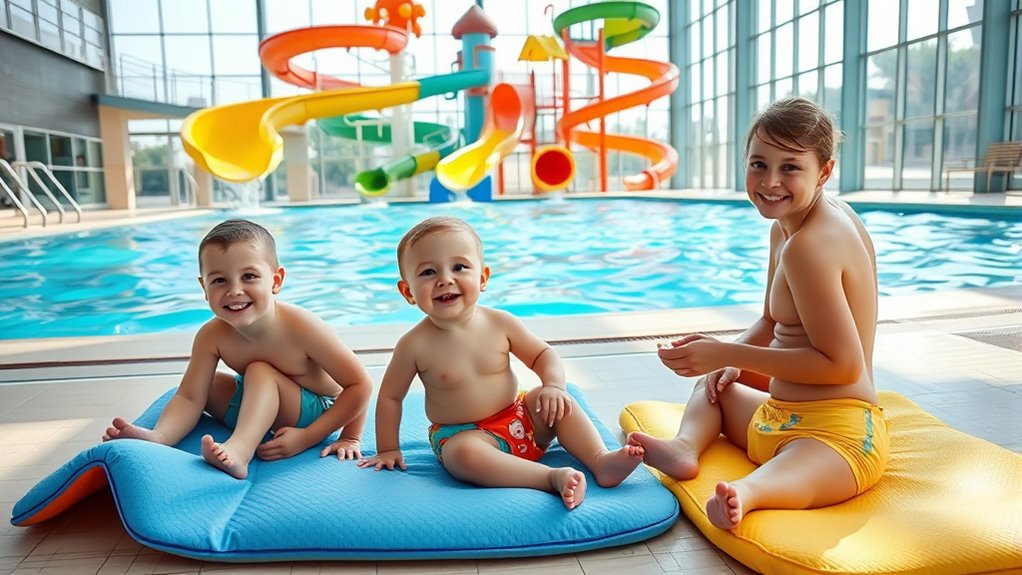
Ensuring your young children’s safety in water parks requires constant vigilance and adherence to key guidelines. You should keep your kids in sight at all times, especially in wave pools or crowded areas. When near water, keep toddlers within arm’s length to prevent accidents. Using the buddy system for older children helps guarantee someone is always with them. Establish a meeting point in case anyone gets separated. Maintain an adult-to-child ratio of at least one adult per child for effective supervision. Always equip children with approved safety gear like life jackets if they’re under 48 inches tall or weak swimmers. Wearing swim shoes can prevent slips, especially in splash zones. Stay alert, follow park rules, and prioritize constant supervision to keep your children safe throughout the visit. Constant adult supervision is crucial to respond quickly in emergencies and prevent injuries. Additionally, being aware of water park safety regulations can help you better prepare and ensure a safe experience for your family.
Proper Use of Swim Diapers and Hygiene Practices

To keep pool water clean and safe, it’s essential to use swim diapers properly and follow good hygiene practices. Confirm the diaper fits snugly around your child’s waist and legs without leaving red marks or causing chafing. Check the fit before entering the water to prevent leaks during swimming. Use disposable swim diapers if you prefer single-use, or reusable ones that require proper cleaning after each use. Layering a reusable over a disposable adds extra protection. Always change diapers in designated areas away from the pool, and wash your hands thoroughly afterward. Remember, swim diapers contain solid waste but don’t prevent urine leakage or fully block bacteria. Swim diapers are designed to prevent the spread of fecal bacteria, and regular bathroom breaks and proper maintenance help keep the water safe and clean for everyone. Additionally, understanding water safety protocols can further reduce risks and promote a safe swimming environment.
Common Hazards and Injury Risks for Babies in Indoor Water Parks
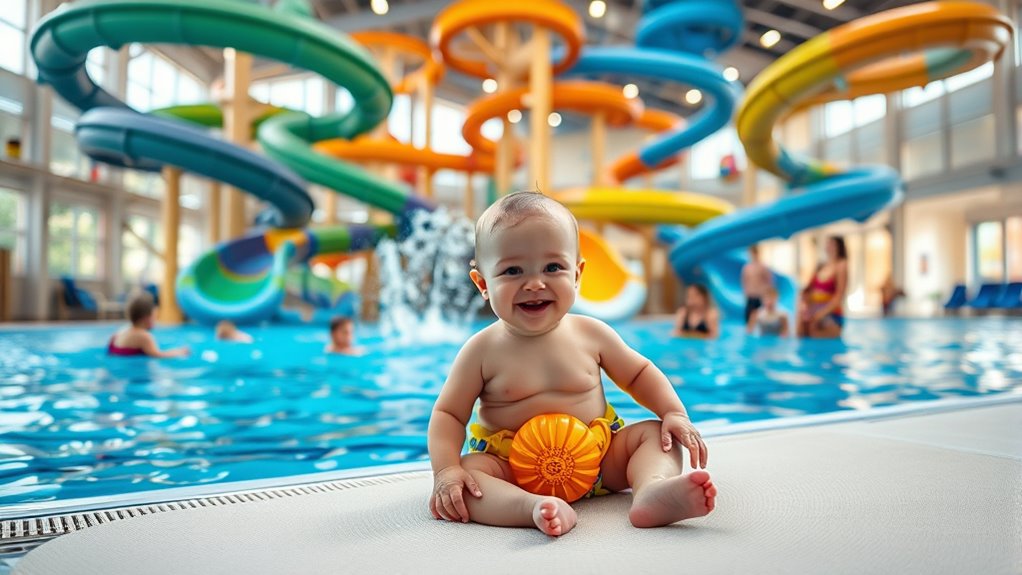
Indoor water parks offer fun and excitement, but they also pose specific hazards that can put babies at risk. Wet surfaces increase the chance of slip and fall injuries, especially since babies are less stable on slick floors. Waterslides can cause scrapes, cuts, or broken bones if a baby is not properly supervised or if they slip while climbing or riding. Wave pools present drowning dangers due to chaotic conditions and strong currents. Waterborne illnesses are a concern because pools can harbor bacteria like E. coli and parasites such as Cryptosporidium, which can seriously affect babies’ developing immune systems. Water quality concerns, including improper chemical levels, can also cause skin or eye irritation. Chemical exposure from inadequate ventilation or improper pH levels may cause skin or eye irritation. Maintaining proper pool maintenance and water chemistry is essential to minimize these risks. Staying aware of these hazards helps you protect your little one during your visit.
Planning Your Visit: Tips for a Safe and Enjoyable Experience
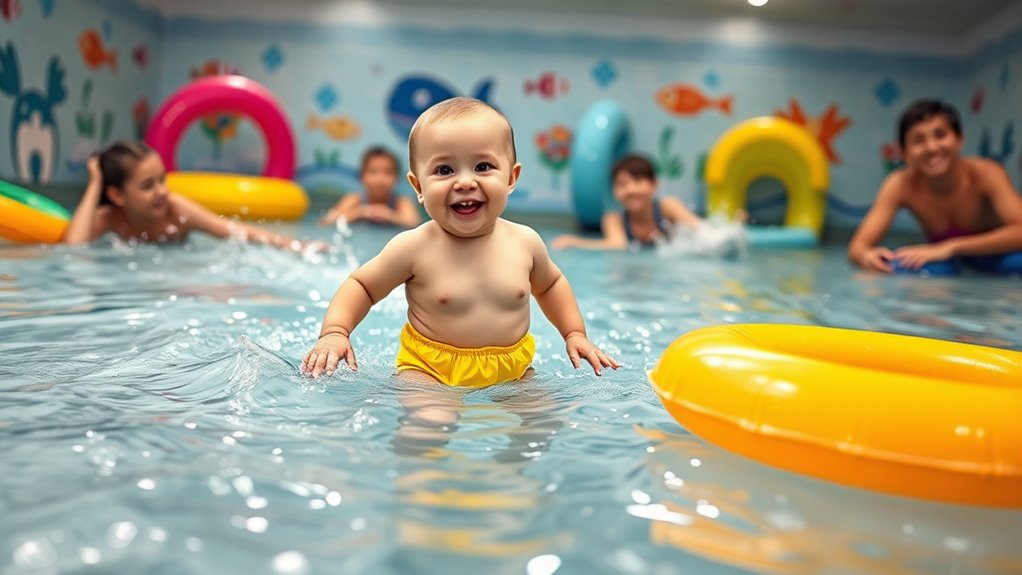
Planning your visit carefully can make all the difference in creating a safe and enjoyable experience at the water park. Arrive early to avoid crowds and get easier access to attractions. Consider visiting on weekdays or during off-peak afternoons for fewer people. Check park hours, especially for indoor water parks with year-round or reduced hours, and see if early entry or timed tickets are available to maximize fun. Allow extra time to help toddlers settle in and observe before participating. Pack plenty of swim diapers, Coast Guard-approved life jackets for kids under 48 inches, and sun protection if outdoor areas are accessible. Bring snacks, water, and extra clothes. Setting clear meeting points and supervising children closely will keep everyone safe and happy throughout your visit. Knowing how to properly supervise children and choose safe attractions can greatly enhance your water park experience. Additionally, understanding water safety tips for infants and toddlers ensures a more secure environment for the little ones.
Maintaining Health and Hygiene in Indoor Water Park Environments
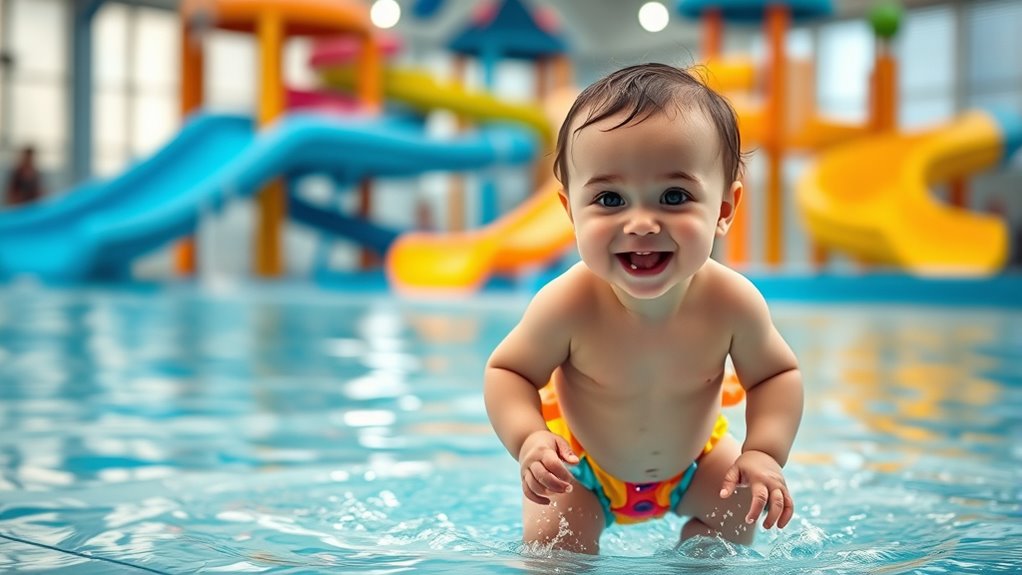
Maintaining health and hygiene in indoor water parks is essential to ensuring a safe experience for everyone. To do this effectively, focus on these key practices:
- Water Quality Checks: Regularly test chlorine, pH, and disinfectant levels—ideally every two hours—to prevent murky water, strong chlorine smell, and foam, which can harbor germs. Proper water maintenance is critical to prevent the spread of viruses through contaminated water.
- Sanitation Protocols: Frequently disinfect high-touch surfaces like railings, lockers, and attraction equipment, especially in themed or hard-to-clean areas, to reduce contamination risks.
- Air and Chemical Management: Guarantee proper ventilation and monitor chloramine levels, as poorly ventilated spaces can irritate respiratory systems and increase illness risk.
Frequently Asked Questions
Are There Age Restrictions for Specific Water Park Attractions for Babies?
Yes, there are age restrictions for specific water park attractions for babies. Most slides and rides are off-limits to babies due to safety concerns, especially high-speed or intense attractions. However, parks usually have designated toddler zones with shallow pools and small slides suitable for babies under 3. Always check the park’s rules beforehand, and keep an eye on signs and staff instructions to guarantee your little one stays safe and enjoys the water.
What Signs Indicate a Baby Might Be Too Cold or Overheated in the Water?
You watch your baby’s tiny fingers turn ghostly pale or bluish, like winter’s chill creeping in. If they shiver, fuss, or seem sluggish, they’re telling you they’re too cold. On the flip side, a flushed face, rapid breaths, or excessive fussiness signals they’re overheating. Keep a close eye, feel their extremities, and trust your instincts—your gentle touch is their best thermometer.
How Can I Prevent My Baby From Slipping on Wet Surfaces?
To prevent your baby from slipping on wet surfaces, make certain they wear water shoes with slip-resistant soles that fit well. Keep a close eye on them, supervising at all times and discouraging running near pools or splash pads. Use slip-resistant mats at entrances and exits, and place wet floor signs in high-moisture areas. Regularly clean and dry spills, and educate staff and caregivers about safety protocols to minimize slip hazards.
Are There Designated Quiet Areas for Babies Needing Rest?
Yes, many indoor water parks have designated quiet areas for babies needing rest. You can find shaded spots, private rooms, or gated play areas that serve as peaceful retreats. Some parks also offer cabana rentals or lounge facilities where your baby can nap comfortably away from the noise. Always check with the park beforehand to confirm available quiet spaces, and plan breaks to keep your little one happy and rested.
What Should I Do if My Baby Shows Signs of Water Allergy or Irritation?
If your baby shows signs of water allergy or irritation, stop water exposure immediately and gently dry their skin. Watch for severe reactions like difficulty breathing or swelling, and seek emergency medical help if needed. Keep calm, monitor symptoms, and avoid hot or cold water. Consult your pediatrician promptly for diagnosis and appropriate treatment, which may include antihistamines and skin care tips to prevent future reactions.
Conclusion
Ultimately, with the right safety measures, your little one can enjoy indoor water parks without turning your day into chaos. Keep a close eye, use proper swim diapers, and follow hygiene tips to prevent accidents and infections. Remember, you’re the captain steering this tiny ship through a sea of splashes and fun—making sure it’s safe and memorable. With careful planning, you’ll create a day that’s as joyful as a rainbow after a storm!

